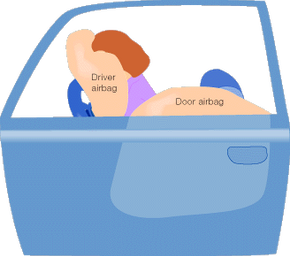The Future of Airbags
Activities aimed at maintaining and improving the lifesaving benefits of airbags are in full swing. New NHTSA-sponsored tests use improved "dummy" injury criteria based on new knowledge and research.
Until recently, most of the strides made in auto safety were in front and rear impacts, even though40 percentof all serious injuries from accidents are the result of side impacts, and 30 percent of all accidents are side-impact collisions. Many carmakers have responded to these statistics (and the resulting new standards) by beefing up doors, door frames and floor and roof sections. But cars that currently offerside airbagsrepresent the new wave of occupant protection. Engineers say that designing effective side airbags is much more difficult than designing front airbags. This is because much of the energy from a front-impact collision is absorbed by the bumper, hood and engine, and it takes almost 30 to 40 milliseconds before it reaches the car's occupant. In a side impact, only a relatively thin door and a few inches separate the occupant from another vehicle. This means that door-mounted side airbags must begin deploying in a merefive or six milliseconds!
Advertisement
Volvoengineers experimented with different ways of mounting side airbags and chose seat-back installation because that protects passengers of all sizes regardless of how the seat is positioned. This arrangement allows them to place atriggering mechanical sensoron the sides of the seat cushions under the driver and front passenger. This prevents the airbag on the undamaged side of the car from inflating. Installing the entire airbag package in the seat-back also offers the advantage of preventing unnecessary deployments that might be caused by collisions with pedestrians orbicycles. It takes a collision of about12 mph(19 kph) to trigger side airbags.
BMW engineers have chosendoor-mounted airbags. The door has more space, allowing for a bigger bag that provides more coverage.
Thehead airbag, orInflatable Tubular Structure(ITS), looks a little like a big sausage and, unlike other airbags, is designed to stay inflated for about five seconds to offer protection against second or third impacts. Working with the side airbag, the ITS is supposed to offer better protection in some side collisions. Another option for head protection in side impacts is thecurtain airbag.
All of this makes it pretty clear that the science of airbags is still new and under rapid development. You can expect many advances in this field as designers come up with new ideas and learn from real-world crash data.
For more information on airbags and related topics, check out the links below.

